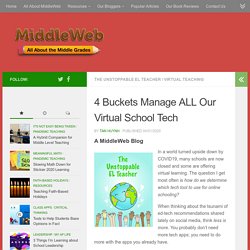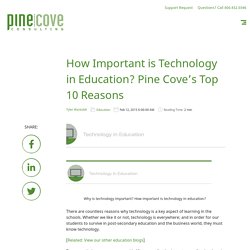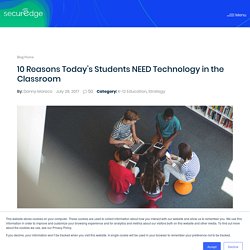

4 Buckets to Manage Our Virtual School Tech. A MiddleWeb Blog In a world turned upside down by COVID19, many schools are now closed and some are offering virtual learning.

The question I get most often is how do we determine which tech tool to use for online schooling? When thinking about the tsunami of ed-tech recommendations shared lately on social media, think less is more. You probably don’t need more tech apps; you need to do more with the apps you already have. This is not an article about which tech tools to use. In this post, you’ll learn more about how I assign a job for each of the tech tools I have in my repertoire. Click to enlarge. To prevent myself and students from drowning in the rising flood of tech options, I have four buckets for technology. Content – comprehensible inputCreate – comprehensible outputCollaborate – student / teacher conferencesCurate – disseminating instruction If a single tool serves a particular purpose effectively, I consider that bucket close-to-full, so I do not need to collect more tech tools.
Technology in Education: An Overview. Published: February 5, 2016 In this 2015 photo, third grader Iyana Simmons works on a coding exercise at Michael Anderson School in Avondale, Ariz. —Nick Cote for Education Week Technology is everywhere in education: Public schools in the United States now provide at least one computer for every five students. They spend more than $3 billion per year on digital content. Led by the federal government, the country is in the midst of a massive effort to make affordable high-speed Internet and free online teaching resources available to even the most rural and remote schools. To keep up with what’s changing (and what isn’t), observers must know where to look.
There’s the booming ed-tech industry, with corporate titans and small startups alike vying for a slice of an $8 billion-plus yearly market for hardware and software. State and federal lawmakers, meanwhile, have wrestled in recent years with the reality that new technologies also present new challenges. How Important is Technology in Education? Pine Cove’s Top 10 Reasons. Why is technology important?

How important is technology in education? There are countless reasons why technology is a key aspect of learning in the schools. Whether we like it or not, technology is everywhere; and in order for our students to survive in post-secondary education and the business world, they must know technology. [Related: View our other education blogs] To narrow it down, we came up with 10 reasons for the importance of technology in education: Students demand it.Students are engaging with technology constantly outside of the classroom. 8 Technologies That Will Shape Future Classrooms. What does the future of learning hold? What will classrooms of the future be like? Emerging technologies such as cloud computing, augmented reality (AR) and 3D printing are paving the way for the future of education in ways we may have yet to see. At the very least though, we can extrapolate from what these promising technologies and predict how schools will adopt them in time to come.
However, just as the original intentions for new technology often give way to innovative and unpredictable usage, we can never be sure if a twist is waiting for these rising stars. Awesome Poster Featuring 11 Ways to Use Technology in Classroom. 10 Reasons Today’s Students NEED Technology in the Classroom. Technology is everywhere--entwined in almost every part of our culture.

It affects how we live, work, play, and most importantly learn. With mobile and other wireless devices like the IoT becoming an increasing requirement across every industry today, it only makes sense that our schools are also effectively deploying mobile technology in the classroom. However, for many schools, implementing the latest technology is a difficult strategy to navigate. There are two main reasons for this: Schools are on the fence about the use of certain mobile devices; thinking they're more a burden than a strategic learning tool.
Schools want to deploy mobile devices but their WiFi networks are not capable of properly supporting the technology In both cases it's a lose lose situation for everyone involved, especially the students. To help your school confidently make the decision to embrace mobile technology in the classroom, we've put together a list of 10 reasons why it will benefit your students. How Education And Technology Are Evolving Together. What will education and learning look like ten years from now?

Originally appeared on Quora: the place to gain and share knowledge, empowering people to learn from others and better understand the world. Answer by Mike Silagadze, Co-Founder and CEO at Top Hat, on Quora: I think the way we best learn won’t change in the next ten years, but the tools we use and what we focus on most definitely will. We will still learn by engaging directly with great educators. 25 Easy Ways to Use Technology in the Classroom. Although many technology-based teaching methods and resources effectively engage students and build their skills, many educators encounter difficulties when using technology in the classroom.
Maybe a specific platform is too hard to introduce. Or maybe it won’t run on your devices. Despite the challenges, you likely want to enjoy the benefits that education technology can deliver. Using the ones that best apply to you and your students, and keeping the condensed list on your desk for quick reference, consider these 25 easy ways to use technology in the classroom: Offering a Unique Learning Experience. Incorporating 21st Century Skills in the Classroom (Video Tool Suite) Opinion Editorials (Op-Eds) | Talking About… | Frequently Asked Questions | Brochures and Explainers Opinion Editorials (Op-Eds) The following op-eds appeared in newspapers and on websites across northern New England.

They cover a wide range of issues but all of them incorporate the framed story of education and learning. Champlain Valley Union High School: an op-ed about the school’s re-design efforts by Andre LaChance, English teacher and school advisor. Theordora J. David Theoharides, Superintendent, Sanford School Department in Maine shares his thoughts on proficiency-based graduation requirements. Talking About… Tammy Davis, Superintendent, Winnisquam Regional School District in New Hampshire, talks about systemic reform in the first in a series of newspaper columns.
The following documents and links reflect recommendations based on the results of research on how Americans think about education and learning. Teacher Tools - Tons of Worksheet and Puzzle Makers. TPACK.ORG. Second 2nd Grade Test Taking Assistance at Internet 4 Classrooms. SAMR Model - Technology Is Learning. Blog. Ed Tech: Future.